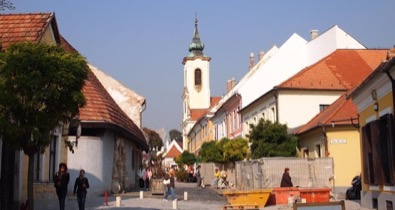2013


There has been feedback that many conservation old towns in China have become overly commercialized for the sake of promoting tourism.
Perhaps, it is true that the lack of standardized conservation rules and regulations, slack enforcement and poor crowd control in China have led to deterioration in some of these old towns. But it might be unfair to say that they are too commercialized. After all, those who have traveled widely will notice that many of the preserved old towns in Europe (for example, Cesky Krumlov of the Czech Republic and Szentendre in Hungary) are equally lined with souvenir shops and restaurants catering to tourists. Definitely, conservation sites needs income to be commercially viable and to be sustainable.
One difference between old towns in Europe and those in China is in the way they are managed. For example, Szentendre is well preserved with buildings and streets dating back a few hundred years. In the 18th century, after liberation from the Turks, Szentendre enjoyed a rebirth with Mediterranean influence. Today, the town is still characterized by a south European atmosphere with much baroque architecture, churches, narrow sidestreets, and cobblestone roads. Around the quaint town square and along the scenic Danube river, souvenir shops and restaurants greet the visitors. Yet, schools and residential houses co-existed in the surrounds. This is a 'living' town where daily lives of the people coexisted with conservation. It is managed just like any other towns.
This is unlike some of the old towns in China such as Zhouzhuang and Wuzhen, where the conservation sites within the compound fences are managed like a theme park, and the residents are either employees or tourists. Of course there are merits to both types of conservation management. For example, it may be easier to maintain the buildings and control the crowd with a theme-park styled management. On the other hand, an 'open' conservation site may require cooperation and coordination among private enterprises, local government and the residents preserve the sight, scenes and soul of the town. Also, cultural and behavioral realities may make it necessary to manage a conservation site within fences.
Tourism and MICE businesses present opportunities as well as pressure on old towns. Eventually, it is a matter of balance to make conservation and tourism work hand-in-hand.
(For more information on Wuzhen as a MICE venue, click here. Szentendre, about an hour train ride from Budapest, does not possess many dedicated convention facilities, but it does have an environmentally friendly conference centre. The REC (Regional Environmental Center) Conference Center aims for zero emission with its architectural design and state-of-the-art technology. It suitable for mid-size conferences (80 and 120 persons) and exhibitions, especially for events with environmental themes. Event organizers may also consider using the City Hall as a conference venue in Szentendre.)
Heritage Conservation and MICE
10/1/13
Conservation of heritage sites and MICE/tourism development need to strike a balance to ensure sustainability of such projects.
© Copyright reserved 2012. No part of this publication may be reproduced without prior permission of the publisher. All trademarks and rights to the photographs, graphics and the MICEreview name are owned by IZESS Pte Ltd.